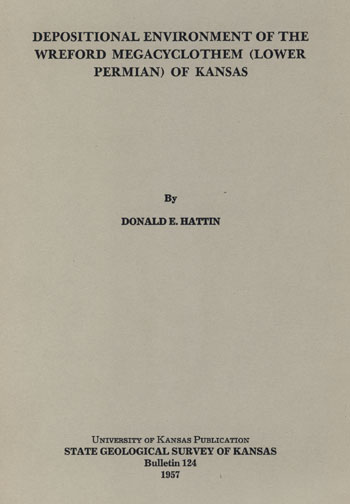Depositional Environment of the Wreford Megacyclothem (Lower Permian) of Kansas
By Donald E. Hattin

Originally published in 1957 as Kansas Geological Survey Bulletin 124. This is, in general, the original text as published. The information has not been updated.
Abstract
The Speiser shale, Wreford limestone, and Wymore shale member of the Matfield formation were studied in east-central Kansas. More than 200 exposures were examined, of which 138 were measured and described. The results of this stratigraphic work have been incorporated into a correlation chart. Several completely exposed sections were sampled, representative specimens from each distinctive lithologic unit being collected for laboratory analysis.
Samples of rock from six key sections were examined in detail to collate information derived from observation of outcrops, polished surfaces of chert, polished and etched limestone surfaces, insoluble residues of limestones, washed shales, sand/shale ratio studies, and pipette analyses. In addition, thin sections were made of sandstones, limestones, and cherts; large blocks of limestone were etched in an acid bath; and three subsurface sections were examined.
A complete stratigraphic description of the outcropping rocks of the Wreford limestone and adjacent shales is presented. The sequence exhibits repetition of lithologies and faunas that is attributed to cyclic sedimentation. Two nearly complete cycles of deposition are recognized, the rocks of each constituting a cyclothem. The two cyclothems, which include strata extending from the middle of the Speiser shale to the middle of the Wymore shale, comprise the Wreford megacyclothem. Each of the major types of sedimentary rock is characterized by a distinctive fossilized biota (or lack of one) and is the product of a particular environment.
Sandstones and red shales are continental deposits. The sandstones are unfossiliferous, representing accumulation in ancient river channels; red shale, bearing sparse charophyte oogonia, accumulated in interfluve areas of a broad low plain that bordered the early Permian sea.
Green shales, grayish-yellow mudstones, and molluscan limestones were deposited in the area between the shoreline and the outer limit of marine waters of less-than-normal salinity. Ostracodes and fragmentary remains of other kinds of invertebrates are characteristic of the first two lithologies; Aviculopecten and Septimyalina characterize the third.
Calcareous shales represent deposition moderately far from shore in marine waters of normal salinity. These rocks contain the most abundant and taxonomically varied fauna of the megacyclothem. Derbyia, Dictyoclostus, Composita, and Chonetes are the dominant megafossils.
Cherty limestones were deposited during the stage of maximum transgression of the sea. Lack of inorganic clastic constituents suggests deposition in clear water far from shore. The fauna includes bryozoans and brachiopods as the dominant types.
Chalky limestones bearing little chert are a special development of the cherty-limestone phase of deposition. They locally form relatively thick reefs, which are dominantly composed of bryozoans and algal remains. The environment of deposition shoreward from the reefs is believed to have been governed partly by their presence.
Algal limestones are present in the regressive hemicycles of sedimentation and correspond in relative position to the transgressive molluscan phases. Some algal limestones are believed to be the product of a hypersaline environment. Algal limestones that contain large burrowing clams and are situated shoreward from the ancient reefs are interpreted as having accumulated in a somewhat brackish environment, because the associated invertebrate fossils are similar to those seen in transgressive molluscan limestones.
In the limestones that were deposited during maximum transgression there are two types of chert. Compact noncalcareous cherts are believed to be primary chemical precipitates; layered or laminated calcareous cherts formed from silica deposited more slowly than the noncalcareous cherts and owe their present appearance to changes that occurred during diagenesis.
The typical transgressive hemicycle in the Wreford megacyclothem begins with red shale (locally with a sandstone) followed, in upward order, by green shale, mudstone, molluscan limestone, calcareous shale, and cherty limestone (including local chalky-limestone reef development). The typical regressive hemicycle includes the same rock types in reverse stratigraphic order except that the molluscan limestone equivalent is commonly algal. Neither of the Wreford cyclothems is complete.
Subsurface sections in which the end members of the hemicycles can be detected indicate widespread distribution of the environments controlling the different phases of sedimentation.
Similar repetitions of lithologic types, each with its particular faunal assemblage, are seen in the stratigraphic sequence above the Wreford limestone up to and including the Winfield limestone.
Kansas Geological Survey, Geology
Placed on web Feb. 16, 2009; originally published April 1967.
Comments to webadmin@kgs.ku.edu
The URL for this page is http://www.kgs.ku.edu/Publications/Bulletins/124/index.html